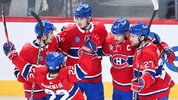It is June 2023 and by all accounts the Habs continue to rebuild.
What is a rebuild? What are the dimensions of a rebuild? How long do they last, what is the desired outcome, what can we expect to see happen? It’s all a bit unclear sometimes but let’s try to clear it up a bit and see what we have.
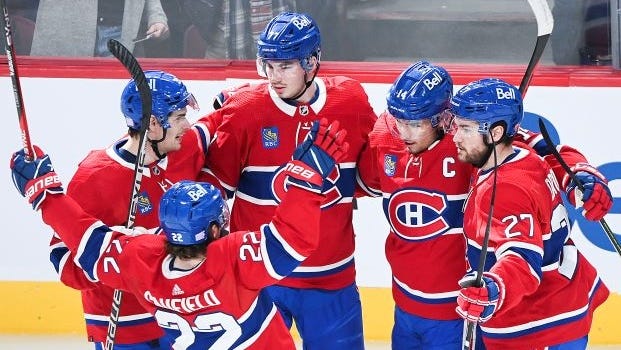
Some Core players and some not-so-Core players
Teams in the first condition above wish to load-up on players who will push them over the edge. Their rosters are more-or-less set, they know their core players; they just want to add skilled depth to make their team more potent. Example: Colorado in the 2021-2022 season, after adding crucial depth players to their well-established core they went on to win the Cup that season.
Teams in the second condition, as in the first condition above, are generally set but would tinker such as moving a major piece to acquire another major piece. The Vegas Golden Knights, for instance, cut LW Max Pacioretty ($7m cap hit) loose in order to better accommodate other acquisitions, among which was star C Jack Eichel and his $10m cap hit.
Teams in the third condition have fallen short of expectations and the management no longer feels they are on an upward trajectory. They wish to re-tool the squad, which involves major changes while not just giving up on a majority of the roster. This implies they don’t expect to lose many games and see themselves as moderately competitive.
And the fourth condition, the rebuild, implies that the current team build is wrong and needs to be scrapped. This means selling or simply churning through players while loading up on future-relevant assets through trades and the amateur draft.
What is ‘future-relevant’? They’re players or draft assets that are expected to matter more in the future than the present. A 2025 draft pick is more relevant to the team at least two years down the line than it is now. Similarly, a drafted 19 year old prospect in the NCAA system will not be relevant to the success of the NHL team any time soon, he is therefore a future-relevant asset, or simply, a future as in: when an NHL player is traded for futures.
The simple truth of the matter is that a team is always building. They are always active, always seeking an edge, always balancing immediate interests against future ones. Their impression of their current roster will determine what their construction moves will look like.
Where does that leave the Habs?
In the 2022-23 season Montreal had 31 wins, 45 losses, 6 overtime losses for 68 points in the 82 game season, which translates to a paltry 0.41 pt%. The Habs had 232 goals scored and 307 goals against for a differential of -75, fifth worst in the NHL.
While many in Habs fandom are lamenting this past season’s Habs roster as being insufficiently bad, it appears that for the upcoming 2023-24 season, Montreal GM Kent Hughes does not expect his team to lose as much as it did last year or the year before.
Conservatively speaking, there are two main factors in this:
Firstly, Hughes expects fewer man-games lost: This calculation is a bit difficult to nail down with consistency but the Habs lead the NHL and lost over 600 man-games both in this past season and the season before. The impact it has had on consistency, performances, morale, and results is immeasurable but we could see the impact: the Habs never gave up but had truly erratic performances and did not win enough points to compete for a playoff position.
Both Hughes and his boss Jeff Gorton lamented the performances of the Physio-Medical department and pledged changes. Just reently two of the main figures of the Habs medical cohort were released which, along with a natural regression to the mean and the shedding of injury prone players like Byron and Drouin, means we can expect fewer man-games lost and considerably less impact on the roster and the team’s consistency, performances, morale, and results.
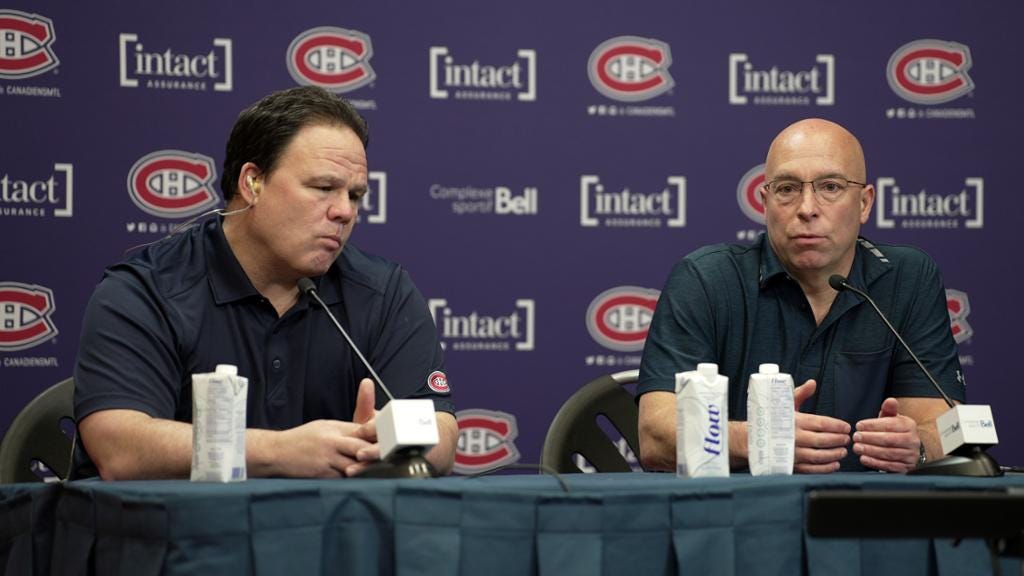
VP Jeff Gorton and GM Kent Hughes during the end-of-season press conference
Secondly, underperforming players will be churned through: Whilst we cannot make any major prediction for how the off-season will fare in terms of roster changes, we expect that the Habs will not have a player as underproductive as Evgenii Dadanov (18pts in 50gp, 17th in pts/gp) or his trade replacement Denis Gurianov (8pts in 23gp, 19th in pts/gp). Injury prone Jonathan Drouin is leaving the Habs after six seasons, his 29pts in 58gp while better than the aforementioned players, is not up to par for a player who is a defensive disaster (-16 in even-strength goal differential, worst forward on the Habs).
In addition to Dadanov/Gurianov and Drouin, the undersized Paul Byron (who missed all 82 games this past season) will likely retire from hockey following his expiring contract, and possibly even the oft-injured Sean Monahan will be released. That’s the churn of four forwards, or a full third, of the on-ice roster in any given game.
Hughes has been left with salary cap room to acquire more cost-effective NHL-level players without breaking a sweat. No matter if Hughes decides to internally promote the overachieving AHL players who broke through the chaos and impressed with the Habs team last year or if he goes to the NHL marketplace for new players, the implication is to expect a more competitive and streamlined team next year by virtue of a more stable roster (fewer injuries) and more efficient players in key positions.
In addition to the changes up front, there will be some tinkering on the defense as well. The Habs started the season expecting Joel Edmundson to play in a top3 defender’s role and he’s sadly fallen off. The rapid growth of young defencemen rookies Guhle, Harris, and Xhekaj means that the Habs will enjoy the luxury of no longer relying on Joel Edmundson. He can be traded away with half his salary retained for a palatable $1.75m cap hit and given his torrid season this past year, it will likely benefit the Habs in terms of on-ice performance.
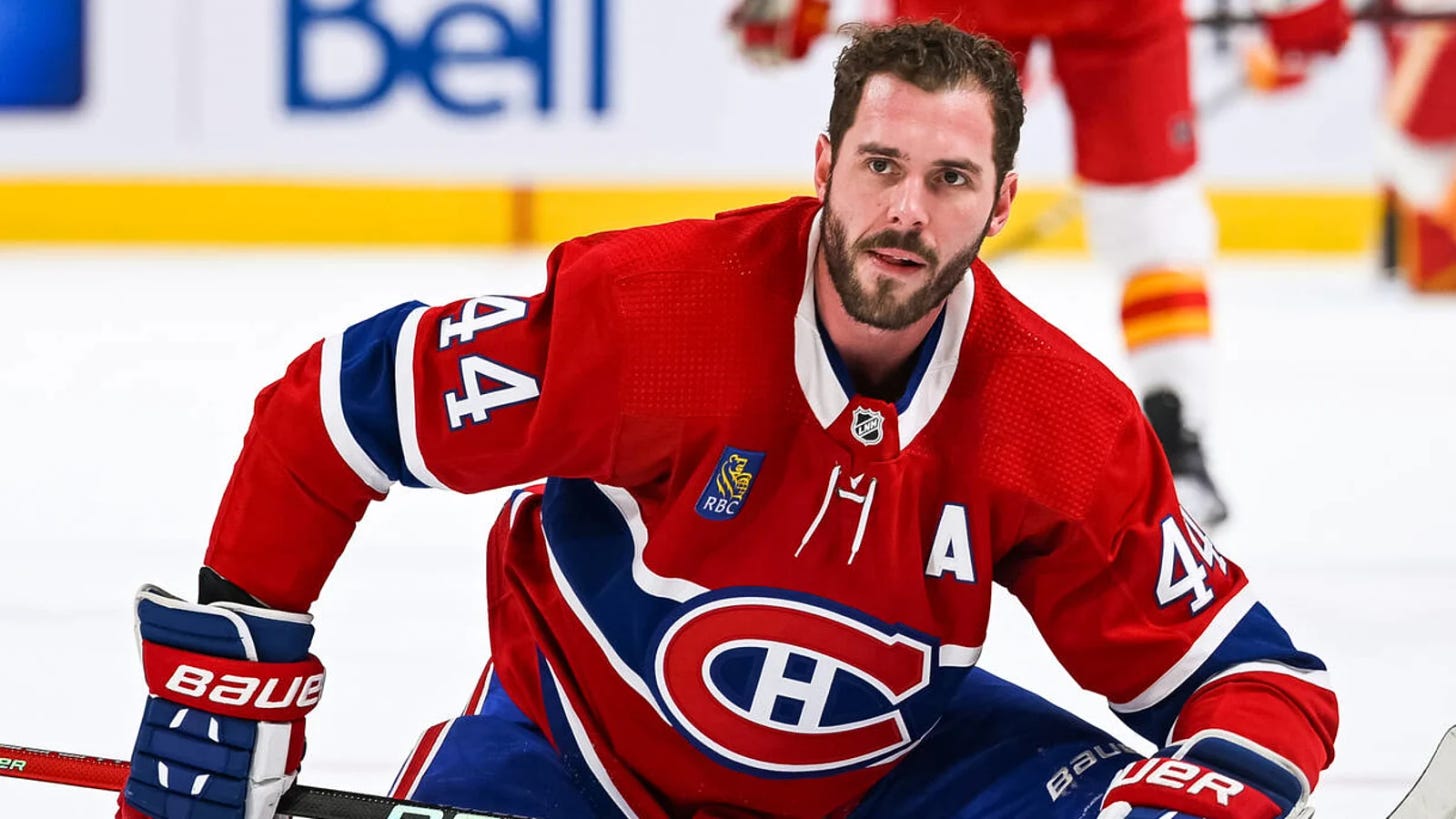
D Joel Edumndson might be entering his last season with the Habs or might be gone before the season starts
So if they’re not expecting to be bottom-barrel, what are the Habs looking toward for next season?
III.
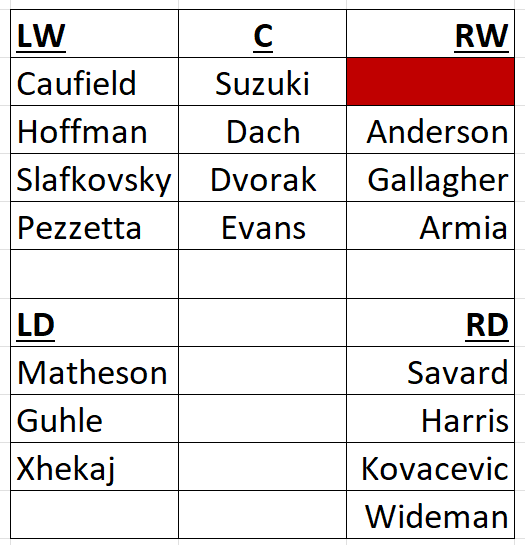
Habs’ NHL depth chart as of June 18th 2023
It isn’t pretty but with ample cap-space, and the anticipated promotion for Rafaël Harvey-Pinard and possibly Jesse Ylönen, any further NHL-level addition to the roster will make for a more competitive and effective team.
The aforementioned roster players who have been churned were either fully MIA (Byron, $3.5m cap hit), MIA for half the season (Monahan, $6.3m cap hit), extremely ineffective (Dadanov/Gurianov, $5m cap hit), or both injury prone and ineffective (Drouin, $5.5m caphit).
Taking into account Cole Caufield’s new contract, the remaining cap space is now roughly $11.5m or 13.7% of a $83.5m Salary Cap ceiling.
Unlike in the first two NHL seasons of Hughes’ tenure where he inherited a catastrophic roster build from his predecessor Marc Bergevin, today the picture is quickly learing up. Hughes’ players are all over the roster and, of the inherited players, those he’s chosen to promote or extend are found up and down the line-up.
The Habs’ roster is taking shape and the upcoming moves will be much more balanced in terms of dismantling the old roster and building the immediate one. With a third of the current forwards gone in a few weeks and possibly Joel Edmundson on defence used as a trade piece, the Habs will be in a position where the only relevant veteran leftovers from the rebuild era transition will be the following players:
With that said, many of the qualities of a re-tool phase are identifiable with the Habs, because re-tooling teams tend to:
At the current juncture the Habs have many options ahead of them and can determine whether to be more aggressive in acquiring NHL talent or more aggressive in acquiring futures but the fact remains they no longer need to sell any players and can instead be more judicious in their roster moves.
Fs Dvorak, Anderson, and Hoffman could have some interest on the NHL trade market but they also remain positive-value for the Habs performances and results — therefore they will remain on the trade-block without any pressure to be sold until the right fit is found.
The Habs also possess three salary-retention slots as of July 1st, 2023 and can utilize them for trades involving 2024 off-season UFAs D Joel Edmundson or F Mike Hoffman for instance.
All of this increased leverage contributes to the Habs’ options in building up the roster but the rebuild phase, where they were quick to sell as much as they could, is definitely over. More exciting and constructive days are ahead.
What is a rebuild? What are the dimensions of a rebuild? How long do they last, what is the desired outcome, what can we expect to see happen? It’s all a bit unclear sometimes but let’s try to clear it up a bit and see what we have.
I.
In the NHL commentary world there are several terms to describe the view of a team’s roster, they are presented below in order of readiness:- Load-up…. or Expect to matter in the playoffs
- Tinker… or Expect to make the playoffs
- Re-tool… or Expect to try to make the playoffs
- Re-build… or Expect to not make the playoffs… or Tank

Some Core players and some not-so-Core players
Teams in the first condition above wish to load-up on players who will push them over the edge. Their rosters are more-or-less set, they know their core players; they just want to add skilled depth to make their team more potent. Example: Colorado in the 2021-2022 season, after adding crucial depth players to their well-established core they went on to win the Cup that season.
Teams in the second condition, as in the first condition above, are generally set but would tinker such as moving a major piece to acquire another major piece. The Vegas Golden Knights, for instance, cut LW Max Pacioretty ($7m cap hit) loose in order to better accommodate other acquisitions, among which was star C Jack Eichel and his $10m cap hit.
Teams in the third condition have fallen short of expectations and the management no longer feels they are on an upward trajectory. They wish to re-tool the squad, which involves major changes while not just giving up on a majority of the roster. This implies they don’t expect to lose many games and see themselves as moderately competitive.
And the fourth condition, the rebuild, implies that the current team build is wrong and needs to be scrapped. This means selling or simply churning through players while loading up on future-relevant assets through trades and the amateur draft.
What is ‘future-relevant’? They’re players or draft assets that are expected to matter more in the future than the present. A 2025 draft pick is more relevant to the team at least two years down the line than it is now. Similarly, a drafted 19 year old prospect in the NCAA system will not be relevant to the success of the NHL team any time soon, he is therefore a future-relevant asset, or simply, a future as in: when an NHL player is traded for futures.
The simple truth of the matter is that a team is always building. They are always active, always seeking an edge, always balancing immediate interests against future ones. Their impression of their current roster will determine what their construction moves will look like.
Where does that leave the Habs?
II.
Here is a bold take: the Habs are now entering the third condition and leaving the fourth. Yes, the Habs are entering the “expect to try to make the playoffs” phase.In the 2022-23 season Montreal had 31 wins, 45 losses, 6 overtime losses for 68 points in the 82 game season, which translates to a paltry 0.41 pt%. The Habs had 232 goals scored and 307 goals against for a differential of -75, fifth worst in the NHL.
While many in Habs fandom are lamenting this past season’s Habs roster as being insufficiently bad, it appears that for the upcoming 2023-24 season, Montreal GM Kent Hughes does not expect his team to lose as much as it did last year or the year before.
Conservatively speaking, there are two main factors in this:
Firstly, Hughes expects fewer man-games lost: This calculation is a bit difficult to nail down with consistency but the Habs lead the NHL and lost over 600 man-games both in this past season and the season before. The impact it has had on consistency, performances, morale, and results is immeasurable but we could see the impact: the Habs never gave up but had truly erratic performances and did not win enough points to compete for a playoff position.
Both Hughes and his boss Jeff Gorton lamented the performances of the Physio-Medical department and pledged changes. Just reently two of the main figures of the Habs medical cohort were released which, along with a natural regression to the mean and the shedding of injury prone players like Byron and Drouin, means we can expect fewer man-games lost and considerably less impact on the roster and the team’s consistency, performances, morale, and results.

VP Jeff Gorton and GM Kent Hughes during the end-of-season press conference
Secondly, underperforming players will be churned through: Whilst we cannot make any major prediction for how the off-season will fare in terms of roster changes, we expect that the Habs will not have a player as underproductive as Evgenii Dadanov (18pts in 50gp, 17th in pts/gp) or his trade replacement Denis Gurianov (8pts in 23gp, 19th in pts/gp). Injury prone Jonathan Drouin is leaving the Habs after six seasons, his 29pts in 58gp while better than the aforementioned players, is not up to par for a player who is a defensive disaster (-16 in even-strength goal differential, worst forward on the Habs).
In addition to Dadanov/Gurianov and Drouin, the undersized Paul Byron (who missed all 82 games this past season) will likely retire from hockey following his expiring contract, and possibly even the oft-injured Sean Monahan will be released. That’s the churn of four forwards, or a full third, of the on-ice roster in any given game.
Hughes has been left with salary cap room to acquire more cost-effective NHL-level players without breaking a sweat. No matter if Hughes decides to internally promote the overachieving AHL players who broke through the chaos and impressed with the Habs team last year or if he goes to the NHL marketplace for new players, the implication is to expect a more competitive and streamlined team next year by virtue of a more stable roster (fewer injuries) and more efficient players in key positions.
In addition to the changes up front, there will be some tinkering on the defense as well. The Habs started the season expecting Joel Edmundson to play in a top3 defender’s role and he’s sadly fallen off. The rapid growth of young defencemen rookies Guhle, Harris, and Xhekaj means that the Habs will enjoy the luxury of no longer relying on Joel Edmundson. He can be traded away with half his salary retained for a palatable $1.75m cap hit and given his torrid season this past year, it will likely benefit the Habs in terms of on-ice performance.

D Joel Edumndson might be entering his last season with the Habs or might be gone before the season starts
So if they’re not expecting to be bottom-barrel, what are the Habs looking toward for next season?
III.

Habs’ NHL depth chart as of June 18th 2023
It isn’t pretty but with ample cap-space, and the anticipated promotion for Rafaël Harvey-Pinard and possibly Jesse Ylönen, any further NHL-level addition to the roster will make for a more competitive and effective team.
The aforementioned roster players who have been churned were either fully MIA (Byron, $3.5m cap hit), MIA for half the season (Monahan, $6.3m cap hit), extremely ineffective (Dadanov/Gurianov, $5m cap hit), or both injury prone and ineffective (Drouin, $5.5m caphit).
Taking into account Cole Caufield’s new contract, the remaining cap space is now roughly $11.5m or 13.7% of a $83.5m Salary Cap ceiling.
Unlike in the first two NHL seasons of Hughes’ tenure where he inherited a catastrophic roster build from his predecessor Marc Bergevin, today the picture is quickly learing up. Hughes’ players are all over the roster and, of the inherited players, those he’s chosen to promote or extend are found up and down the line-up.
The Habs’ roster is taking shape and the upcoming moves will be much more balanced in terms of dismantling the old roster and building the immediate one. With a third of the current forwards gone in a few weeks and possibly Joel Edmundson on defence used as a trade piece, the Habs will be in a position where the only relevant veteran leftovers from the rebuild era transition will be the following players:
- F Brendan Gallagher ($6.5m cap hit)
- F Josh Anderson ($5.5m cap hit)
- F Mike Hoffman ($4.5m cap hit)
- F Christian Dvorak ($4.5m cap hit)
- F Joel Armia ($3.4m cap hit)
- D David Savard ($3.5m cap hit)
- D Joel Edmundson ($3.5m cap hit)
IV.
Re-tool isn’t the most accurate term to describe the phase after rebuilding but before competing because it’s more often used to describe a descending or struggling team than an ascendant one.With that said, many of the qualities of a re-tool phase are identifiable with the Habs, because re-tooling teams tend to:
- Have an identified core and are not afraid to commit to core players despite the results of the team. Caufield’s recent contract extension confirms that Kent Hughes has no interest in churning through players for the sake of chasing some sort of perfect roster build with handpicked players. Instead Hughes has cut the wheat from the chaff and jump-started his team’s rebuild process by committing to players he identifies as core pieces such as LW Caufield, C Kirby Dach, and D Matheson — two of which were acquired by trade.
- Have a direction and a desired player profile. Unlike rebuilding teams, the Habs know the manner in which they want to play and with what sort of player types to target despite not achieving the results to match yet so far.
- Have demonstrated interest in adding NHL talent rather than only futures. Futures help in the future, NHL talent is implicated in the immediate fate of the current roster — this implies the team that acquires NHL talent (instead of futures) has identified the way forward with their core. Other than the aforementioned Kirby Dach, as an example, D Mike Matheson was 28 years old when he was acquired by Hughes in exchange for a demoralized and checked-out D Jeff Petry who was 34.
At the current juncture the Habs have many options ahead of them and can determine whether to be more aggressive in acquiring NHL talent or more aggressive in acquiring futures but the fact remains they no longer need to sell any players and can instead be more judicious in their roster moves.
Fs Dvorak, Anderson, and Hoffman could have some interest on the NHL trade market but they also remain positive-value for the Habs performances and results — therefore they will remain on the trade-block without any pressure to be sold until the right fit is found.
The Habs also possess three salary-retention slots as of July 1st, 2023 and can utilize them for trades involving 2024 off-season UFAs D Joel Edmundson or F Mike Hoffman for instance.
All of this increased leverage contributes to the Habs’ options in building up the roster but the rebuild phase, where they were quick to sell as much as they could, is definitely over. More exciting and constructive days are ahead.

